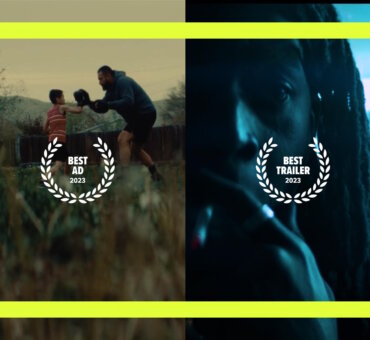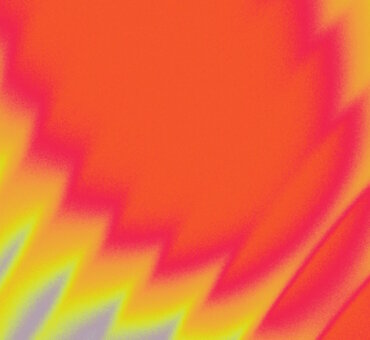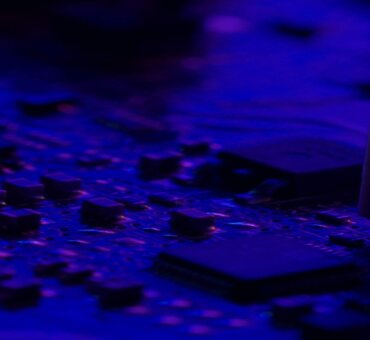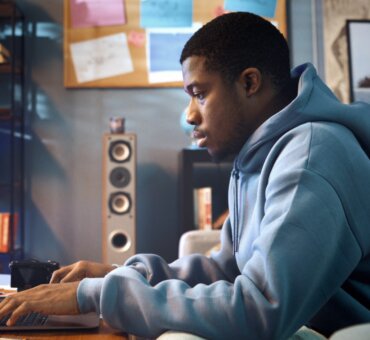Key Points
- How to balance being an authentic artist and pursue commercial work.
- Amy Gardner’s process behind choreographing a sequence.
- Collaborating with your subconscious to create original work.
- An Exclusive Feature of Amy Gardner’s The Gold Inside.
Amy Gardner is an artist and filmmaker who’s work speaks for itself. What’s interesting about Amy’s journey as a filmmaker is that she came into filmmaking after a career in dance and choreography, doing everything from dancing for Madonna to choreographing Jodeb’s “Life In Grey”. To her, filmmaking is a limitless medium that has expanded her mind as an artist. Her debut as a director was FUEL, an 11 minute movement based film that explored the complexities of feminism and human nature.
We sat down with Amy to hear about her latest project “The Gold Inside”, a movement based film project she built around a process over a specific concept or predetermined result. It’s a unique perspective and one we can all learn from.
Jodeb’s “Life in Grey” music video was our first real introduction to your work. How did that opportunity come up and what was your role in it?
I received this crazy treatment for a music video that Jodeb and Kristof Brandl were working on. At the time, I had no clue who Jodeb or Point Point were. I didn’t even know what Vimeo was. One of the producers on the project asked me if I knew a choreographer and my response was that I would rather choreograph the video than just dance in it. They agreed to let me do both! Life in Grey was the first project that introduced me to the film world and I realized how much I enjoyed filmmaking and I knew I wanted to keep doing it.
What’s your process like when it comes to choreography?
The first thing I ask myself is, “Why would I do this as a dance instead of something else?”, because in some situations, there are better ways to express an idea than dance, so why choose dance? Dance expresses emotions that cannot be said with words. There are so many feelings and experiences in life that cannot be expressed in only words.
Dance isn’t only about big legs and crazy choreography, it’s also something as simple as body language. Just by doing a movement like tilting my chin up and opening it to the left, I’m exposing my neck in a way that’s vulnerable. Then, changing the one shoulder makes it more romantic, or bending the left knee makes it depressed. It’s this subconscious and artistic way of telling stories. That’s where movement, or dance is specifically interesting in storytelling. It’s not black and white.
What motivated you to start directing your own work?
As a dancer, I have pursued both the commercial and company world of dance, and have often felt conflicted as to who I wanted to be as an artist. There was a pivotal moment in my career when I was hired to work for Madonna as her body double. While the experience was amazing, something struck me that day and I realized that I needed to make a shift in order to find a deeper sense of fulfillment. I decided to pursue the arts because I genuinely love it and I wanted my career to represent who I really am.
That’s when I decided to start my own company called annoDAM. My goal was to create an umbrella where I could develop my own work. I wanted to make something that was mine and that felt authentic. I still work in the commercial world and love it, but creating annoDAM has brought balance to my career and is the place I know I can always produce my own work. Ultimately, that is what led me to directing.
Photo by: Lauren Withrow
What have you learned from directing?
In the past couple of years, I have learned that the term directing is really ambiguous. It can mean so many different things. When it came to FUEL, I had the idea for it, I wrote it and then I assembled a team. I am still shocked at how many people believed in that project, almost more than I did at times. That’s what kept me going as a director. Without a great team, you can’t make a film by yourself, it is really such a collaborative effort. Although I directed it, the FUEL would not have been completed without an amazing team.
Being an artist, you often think about what type of artist you are. Am I an artist or am I a commercial artist? Where is that line drawn? Recently, I had a big job offer come my way, and I was ecstatic. I worked on it for months. I did a massive treatment. It would’ve been the biggest job I’ve worked on. I would have both choreographed and directed. It would have been the biggest budget I’ve ever worked with, biggest artists I’ve ever worked with and creative I loved. A couple of months into it, it fell through and I was devastated. In that moment, it felt like the end of the world. It’s hard to put in so much for work into something that doesn’t happen. It ended up being a great learning experience for me. I have found patience in the pursuit of my art and discovered a new found faith in myself and my career, regardless of the ups and downs of our industry.
[vc_gallery type=”flickity_style” images=”1534,1533,1531,1532,1530″ flickity_controls=”material_pagination” flickity_desktop_columns=”1″ flickity_small_desktop_columns=”1″ flickity_tablet_columns=”1″ flickity_box_shadow=”none” onclick=”link_no” img_size=”2000×1326″]
Tell us about this new project you’re working on.
The Gold Inside is a movement based film series that began last May. I remember having an idea that I was really excited about and a week later I saw 2 to 3 pieces come out with that same concept. I realized that my subconscious mind was being influenced and that without completely cutting off this intake from my online community, I would have to be more mindful and develop a system up to ensure that I was producing truly original work. It was at this time that I decided that I wanted to direct a piece that honored a process over a consciously driven outcome.
I began studying the work of Francois Morellet, a French contemporary painter, sculptor and light artist. His process employed randomization. He believed that the meaning of his art was not up to him, but to his audience. In his early works, he would begin with 11 simple choices; like his canvas and his brushes. I decided to apply that concept to my process.
I created a twofold system for extracting movement from the dancers. The first part was called Elements of Chance. Once the DP and I establish the shot, I open up an action thesaurus for actors and randomly select a word for my dancer, which serves as their direction for that take (words used included carve, manipulate, seduce, destroy, inhibit, amongst others). Each take lasted between 30 to 90 seconds. We repeat this process 11 times. The second part involved conducting an intimate interview. Dancers were asked to give their responses with movement, enabling them to be extremely open and vulnerable. The purpose was to extract emotion that was raw and honest.
Do you plan to keep building this project?
My initial instinct was to take this footage and edit something immediately, as I was eager to release my latest creation. I spent months playing with several versions, but for one reason or another, it never seemed to feel right. It was while watching Sally Mann’s latest documentary, however, that I found a deep appreciation for the amount of years and work she put into developing a show. She gave it room to grow and breathe, and it hit me, that this was exactly what I needed to do with this project. If we are going to create the same quality of work as those we admire most, I believe we must give ourselves time to develop. In our day and age, there seems to be a need to be constantly producing and posting new work. I find this pressure to stay relevant can be depleting, and ultimately can hinder the integrity and caliber of the work. When I look at the artists I hope to be like one day, there was always patience and honor for their art form, which I hope to carry through in my life as well. This has been a really profound learning curve for me over the past few months and definitely a tricky balance career wise.
To date, we have repeated this process 3 times. The goal is to collaborate with 8 more muses and DPs around the world, so that I am left with 11 subjects and 248 shots. I would like to present the work as a photographer would present a show— have it exhibited in a gallery. Eventually, I will release an online cut, but that is a long ways away, as I like the idea that this piece can only fully exist as a live work. With everything being so accessible these days, it really excites me to commit myself to something more obscure and exclusive.
To date, my collaborators include filmmakers, Matthew Ballard and Jac Martinez. My muses have been Morgan Bobrow-Williams, Leal Zielinska and a duet featuring Cesar Brodermann and Sebastian Abarbanell. I am endlessly grateful to my collaborators so far. Their talent and values shine through in many ways, and the process of creating together has been something I will cherish forever. Jac and Morgan ran around the LES with me until 4 AM getting all the shots we needed and Matt turned down commercial work and flew himself to NYC from LA to contribute to this crazy idea of mine. He also donated all of his own film. The dancers involved are undoubtedly some of my favorites in the world and were all so open and generous in sharing themselves with me. I truly feel so honored. Another thank you is in order to Filmsupply for taking the time to ask me about this film series and sharing it with your community.






